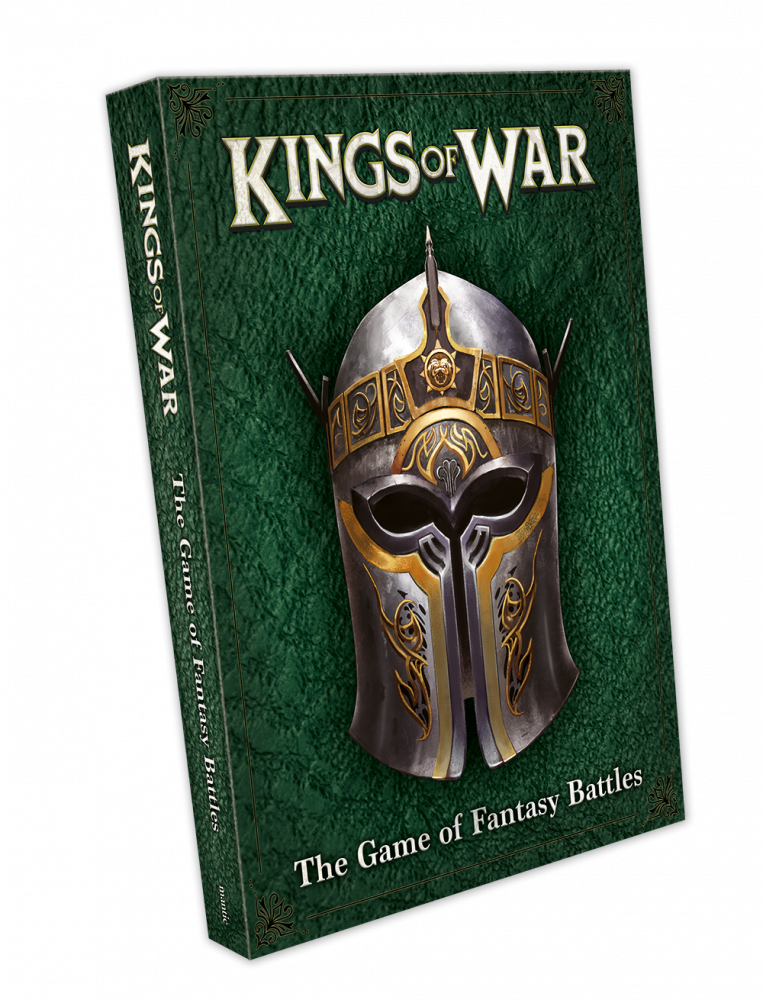G’day, Goonhammer readers! This is the first in a series of articles covering the strategic thinking involved in each level of the thrilling fantasy battles game that is Kings of War. Starting from today with army list construction, we hope to provide a digestible breakdown of the decisions involved in putting together an army from the myriad of choices available to each faction. This is by no means an exhaustive guide, but we hope that this helps the newer commanders of tiny models quickly get to grips with the tactics involved in this early part of the game.
An army in Kings of War is always built with a distinct purpose in mind, with every unit having an assigned role. The correct use of these units can be the difference between victory and defeat, particularly as there are no auto-winning units or combos in Kings of War. Without a full understanding of how an army list works, and then applying it to the various battlefield situations that may arise, a player will always be on the backfoot.
Unlocking units
Before we dive into the list, it’s important to cover the primary mechanic that limits list building in Kings of War. The world of Pannithor is full of fantastical monsters, epic heroes and devastating war machines, yet to take these in an army, one needs a sufficient number of ‘unlocking units’. For instance one regiment of infantry (20 infantry) allows you to include one monster, hero, titan or war engine, as well as two troop-sized units. The bigger the unit size, the more unlocks granted, with a handy diagram in the rulebook (see below).
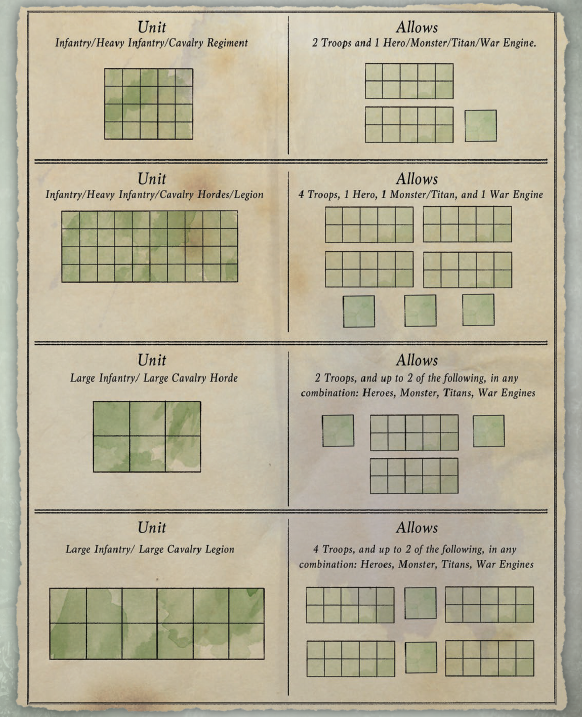
This unlocking system helps to balance the composition of armies, and is not dissimilar to the army composition in other games many would be familiar with.
- Warhammer Fantasy Battles required at least 25% of an army be Core units, with limitations on Special, Rare, Hero and Lord units.
- Warhammer Age of Sigmar stipulates a minimum amount of ‘Battleline’ units be taken in any given army.
- Warhammer 40K’s Patrol and Battalion detachments require a minimum number of ‘Troop’ type units.
The difference with Kings of War compared to the aforementioned game systems is that the range of units that unlock is huge! It is not just the average infantrymen that unlocks, but monstrous units (like Trolls or Elementals), as well as most cavalry. This opens the floodgates of army creation creativity, where armies can be made up of all cavalry (who doesn’t love a good cavalry charge?) or monstrous creatures.
There are a few units in each army that do not unlock, and these are termed Irregular. Often these will be archer units or swarms, and this prevents armies being entirely made up of these kinds of units. This rarely impedes what kinds of armies you want to create, yet it is important to be aware of.
The Army List
In this article, we will be using the most vanilla of factions, the Kingdoms of Men. They have access to nearly all types of units, but, like a tub of vanilla ice cream, are not exceptional in any way. Hence the Kingdoms of Men provides the basic unit templates that all other armies in Kings of War are based off of.
Here we’ve written a very average list that can play all parts of the game reasonably well, and gets to play with all of the cool toys in KoW. We will cover the tools to deal with similar style lists, as well as the roles of each unit; why they’re in and what’s a sensible way to use them.
The army lists and unit profiles presented below were obtained from Mantic’s own list editor, EasyArmy. This is free to use, although the ability to save multiple army lists requires a subscription (which we heartily endorse). The actual printed rules for the Kingdoms of Men are available in the Uncharted Empires supplement book.

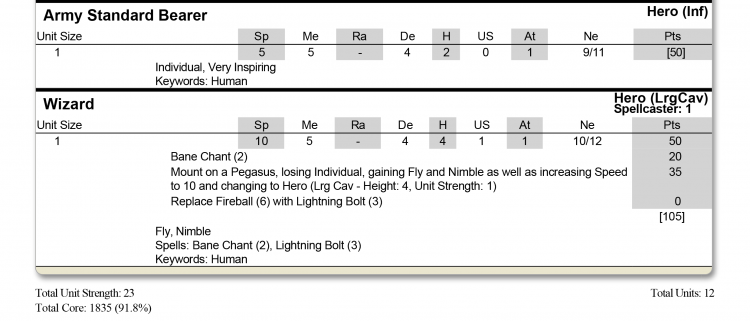
Shield Wall regiments
The Shield Wall are the most basic of regiments, and are the go-to unit for unlocking more heroes, monsters or war engines. With the most average melee output (Me 4+), defense (De 4+), and nerve (Ne 13/15), they are just tough enough that your opponent will actually have to invest real resources to take them out in a single charge.
For you, the player, the Shield Wall are good objective holders thanks to their considerable unit strength (US 3) and their low points cost (100 pts) means you won’t feel bad using them to hold an objective in your home turf.
Concerned about your opponent’s cavalry getting a flank on your Foot Guard? Stick a Shield Wall regiment in between and worry no more! Shield Wall are great for getting in the way of the enemy, blocking charges on your more precious units in the list. Their cheap cost means that if they rout, it’s no major loss to your army.
Foot Guard horde
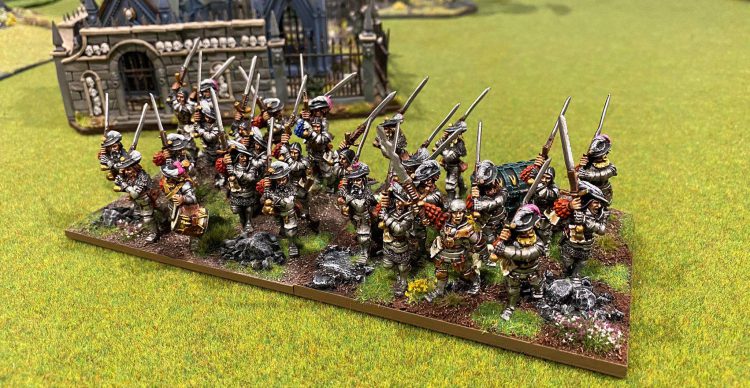
Every Mixed Arms force needs a solid anvil unit, and this is the role of the Foot Guard Horde. They have high defence (De 5+) and high nerve (Ne 21/23), which means that your opponent will have to send in at least two hard-hitting units to reliably beat them. Yet their better melee output (Me 3+) combined with their 25 attacks cannot be ignored; they will hurt something!
The reasoning behind taking one horde rather than two regiments is not just because of the cheaper cost for similar damage output. Like distilling a fine liquor, the concentration of such damage output onto one unit maximizes any enhancements through magic items or spells. With a bit of extra punch (such as via a cheeky Bane Chant), a Foot Guard horde will strike fear into any foul beast or wretch!
This is the kind of unit you use to anchor part of your line, be it the centre or a flank, and grind with the enemy until the fight is over or your cavalry sets up for a charge. Because of its large footprint, having Shield Wall or other cheap regiments to help protect from unwanted charges are a must have. Hence when putting in big blocks of powerful units, it’s always important to consider what units they will need to help them do their job. Their entourage, if you will.
Fanatics regiments
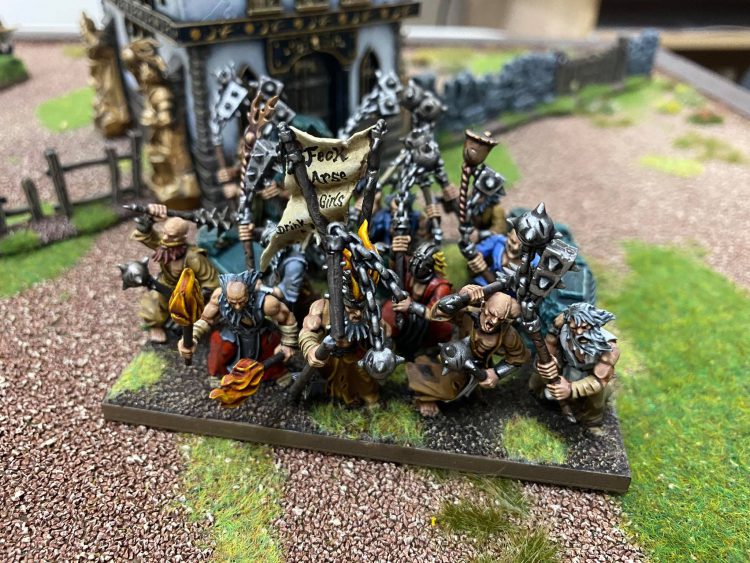
The crazy berserkers of the Kingdoms of Men, these guys can hit quite hard thanks to their good melee (Me 3+), high number of attacks (At 15), and crushing strength 1 (add one to wound rolls). The Wild Charge D3 adds some extra speed (up to 3” on the charge) so that these Fanatics will often hit first. A perfectly valid tactic is to charge the enemy and hold them up while the Foot Guard take their time getting there.
The downside is that Fanatics will quickly accumulate damage due to their low defence (De 3+). This is somewhat mitigated by their fearless nature (Ne -/15; cannot be wavered!). Hence your tactics will not be ruined by a unit of Fanatics getting in the way. Either they are dead, or helping you with your next charge.
Knights horde
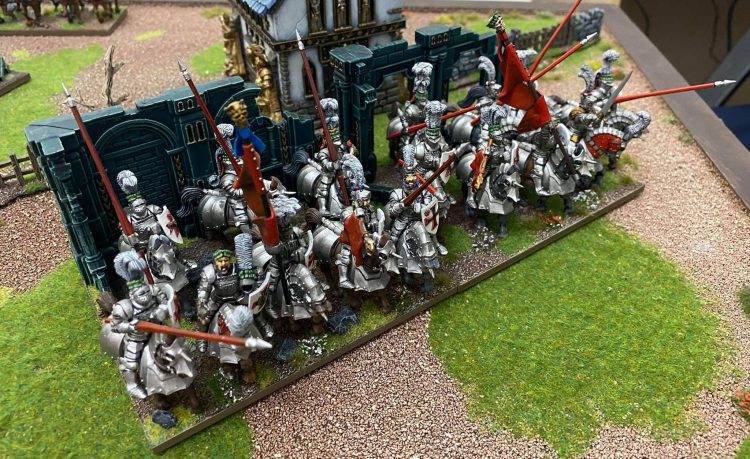
A horde of Knights are the ultimate hammer in this army. With good melee (Me 3+), an atrocious number of attacks (At 32) and good armour piercing (Thunderous Charge 2), there is very little that can withstand a perfect charge from these resplendent warriors. Add to this their high defense (De 5+) and nerve (Ne 21/23), and you have a unit that can do a lot of work across a game.
Hordes of Knights are not all upside. Cavalry units need to be set up correctly so that when they get their moment to charge it is not ruined by difficult terrain (which negates the Thunderous Charge bonus). While a lot of this can be avoided in deployment and movement (see later articles), this can also be addressed in the army list construction phase thanks to magic items (see below). This unit already comes with a hefty price tag, so you’ll need to be careful with them.
Cannons
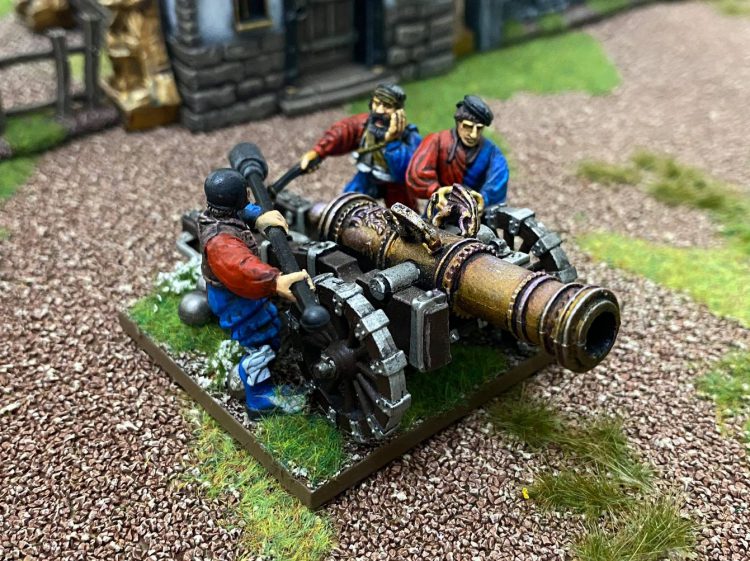
This army, as can probably be surmised, is not one that relies on ranged firepower to win the day. However, a little long-ranged damage accomplishes two things; to damage literally any unit that’s a priority, and force the enemy to get moving. If no shooting is included in an army, many opponents are liable to move up cautiously, waiting for you to make the first mistake. Hitting them with cannonfire puts the pressure on, and is just more fun.
The reason two cannons are included is to ensure that on average at least one shot hits per turn. A single cannon can go an entire game missing thanks to the relatively poor ranged hitting value (Ra 5+). Thankfully when they hit, they nearly always hurt!
Giant
This is where our standard human army starts to get a bit fantastical. The Giant is included in this list to break the unbreakable and stop the unstoppable. With a terrifying amount of armour piercing (Crushing Strength 4!), he will reduce any enemy unit to pulp. He also moves a bit faster than your infantry (Sp 7), and has Strider (no difficult terrain penalties on the charge), so your opponent will have to constantly keep an eye out for him. Use him to protect your Foot Guard horde or accompany the Knights up the flanks.
General on Winged Beast
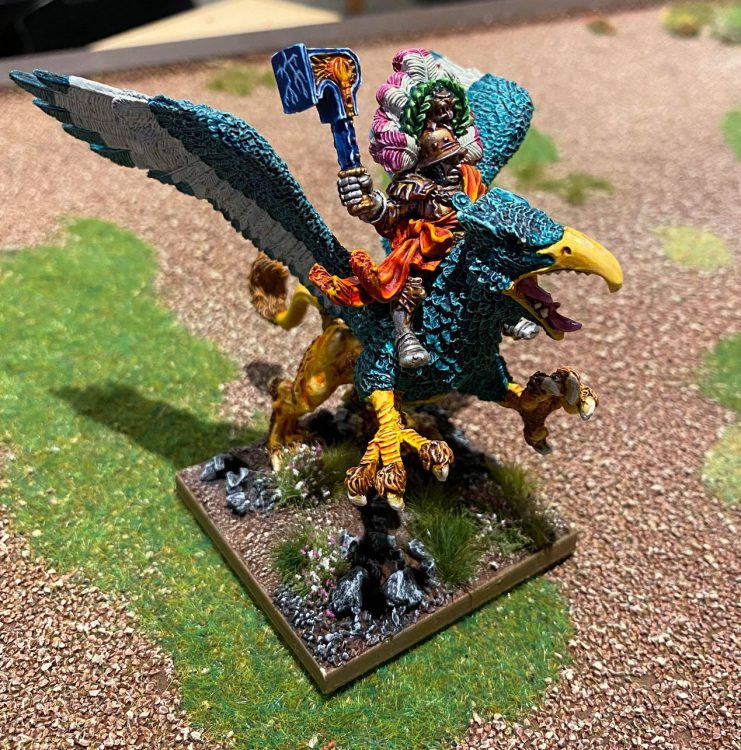
The big boss of the army, the General on Winged Beast is your first source of Inspiring (nearby units can reroll failed nerve tests). Nearly all army lists include at least two sources of Inspiring to ensure all the units we have talked about above can survive a lucky roll of your opponent when they inevitably hit you.
A General on foot or on horseback would suffice for simply this purpose, but putting him on a Winged Beast means he can quickly move across the army to where he is needed. The Winged Beast is also considerable in combat (Me 3+, At 7, Crushing Strength 2, Thunderous Charge 1), so it’s also important to be aware of any potential flank charges that might appear. He is best sitting behind or between units within his Very Inspiring range, and waiting for a good charge.
Army Standard Bearer
The second source of Inspiring in this list, the Army Standard Bearer doesn’t do much else. Since he can’t get around much, he should always be around your key units such as the Foot Guard horde. Hence regardless of where your General is, the Foot Guard are taken care of. If you want to get some extra use out of your Army Standard Bearer, they are a great choice for some key magic items (discussed below).
Wizard

The wizard is a utility piece that can be built in a variety of ways, depending on what you want out of them. From buffing (Bane Chant) and healing (Heal) to damage dealing (Fireball and Lightning Bolt) and utility picks (Wind Blast). Be careful though, adding extra options gets expensive quickly, and you can only cast one spell a turn.
Here, we’ve swapped Fireball for Lightning Bolt (Piercing 1 and extra range) and added Bane Chant to add extra Crushing Strength where it’s needed. Adding a Pegasus also gives extra height, to make sure we can target what we want, and more importantly, gives them Fly and Unit Strength 1, allowing the Wizard to grab objectives for us later in a game.
Magic Items
The keen-eyed among you may have noticed we haven’t hit our points limit yet. Like many wargames we can change the equipment on our units to change their role in the game. In Kings of War, this can come at a variety of costs; the most potent items are also the most expensive, so you want to have a solid goal in mind when purchasing items.
In general, there are three broad categories of magic artefacts:
- Force multipliers- items that make units stronger and/or more consistently effective.
- Weakness mitigation – items that overcome an inherent weakness in the unit, such as low nerve, or a reliance on Thunderous Charge.
- Utility – items that when applied completely change the way a unit works and what its purpose is.
Ultimately, the primary consideration when buying magic artefacts are “Why am I buying this?” and “What unit is it going on?”
Enhancing our hammers
If you’re looking at force multiplication items, they tend to be quite expensive. In fact the bigger the unit you put them on (Regiment vs Horde), the more expensive they get. However, the concentration of these exceptional buffs can be worth it.
For example, putting the Brew of Sharpness (+1 to hit in melee), is going to be much more effective on the Knights with their 32 attacks rather than on the Shield Wall (12 attacks). But the problem for the Knights isn’t doing damage when they get into combat, it is getting there in the first place.
A savvy opponent will use terrain to their advantage, likely making our Knights hindered (-1 to hit and -1 Thunderous Charge), vastly reducing their effectiveness. The large base size of our horde wil alsol make it hard for us to avoid any intervening terrain our opponent might be hiding behind/in.
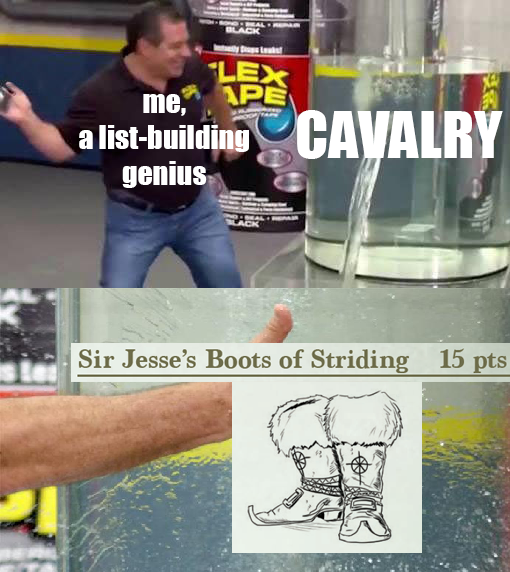
If we look at the Magical Artefacts available to us in the Core Rules, we can see Maccwar’s Potion of the Caterpillar. This gives a unit Pathfinder, allowing it to ignore the penalties of difficult terrain. Hence our Knights are effectively getting +1 to hit and wound in terrain, and it’s less than half the price of the Brew of Sharpness mentioned above.
This ability to ignore difficult terrain also applies in the movement phase. Giving us more options in deployment and letting us project a large threat area while hiding in a forest.
Bolstering our anvils
We can also use Magical Artefacts to buff our anvil units. Extra healing, extra nerve and ways to ignore wavering are all options to enhance survivability, and help your units perform better in their roles.
The Foot Guard horde we have is a great anvil already, but with items that can help them get wounds back, they might last even longer. Items like Healing Brew, Hann’s Sanguinary Scripture, and Aegis of the Elohi all act to heal a small amount of damage. At face value, these might seem only tokenistic, but think of it instead as bonuses to Nerve. The 21/23 horde with 2 damage healed is actually 23/25 – it survived 2 more points of damage than it otherwise might. The only caveat to this interpretation is that you need to have a chance to apply the healing. If the unit is removed in one round of combat, it’s all for naught. Hence, such healing items are best given to the units that are most likely to survive any initial combat.
A fun option can also be applying the Red Pendant of Retribution, so when your unit perishes they explode. While expensive, no one will be too interested in charging our Fanatics if they explode and do 2D6, Piercing 3 hits to everyone in base contact on their death!
Items with character
There are some items that can only be taken on heroes, and they can define the roles they play, or add some utility. Our Army Standard Bearer currently just stands around looking pretty to Inspire the troops, but we can give them an item to let them actually do something during the game.
The most common item to add to such heroes is the Lute of Insatiable Darkness, which bestows the ability to cast the spell Bane Chant for buffing our front line. Other interesting options include adding Heal or Wind Blast can be an interesting pick through the respective items Shroud of the Saint and Zephyr Crown.

Our Wizard can also be focused in a particular direction. Adding The Boomstick for extra Lightning Bolt will turn him into a true damage dealer. Yet, if we’d rather focus on the buffs, the Conjurer’s Staff allows 1 re-roll of a spell dice per turn. This almost guarantees that a critical Bane Chant works when you need it to.
Our General on Winged Beast can also take items, but which ones depend on how he will be used throughout a game. If primarily a source of Inspiring, then the same items that work for the Army Standard Bearer could work here. If, however, the General might get into a few combats, then a cheeky Blade of Slashing will help ensure his high value attacks hit.
Why not more units instead?
Even after all that, you may find you don’t actually want any items, and would rather focus on extra units instead. This is also a viable way to go. The more units on the field, the more options you have, but remember; the important part is to consciously be thinking through and making these decisions. More units is definitely helpful, but so is a cavalry unit that can go through terrain unhindered.
Where to from here?
All the armies of Kings of War have their own similar units to those in the Kingdoms of Men, with some better, and some worse. Most armies lean into specific types of lists according to the units they have available. In our earlier articles we covered all of the Good, Neutral and Evil factions of Kings of War, including a summary of their strengths and weaknesses, and it is these that usually dictate what kind of army list a faction might bring. A Dwarf army full of Earth Elementals and Cannons is no surprise, but an Orc army of Skulks might struggle.
That all said, ultimately Kings of War is a game of fantastical battles between amazing armies that we all put the time in to lovingly bring to life. Any army that makes you excited to build, paint and play is the army that is worth playing. We just provide these examples and tips so that you can do the best that you can with the army that you love.
Have any questions or feedback? Drop us a note in the comments below or email us at contact@goonhammer.com.
